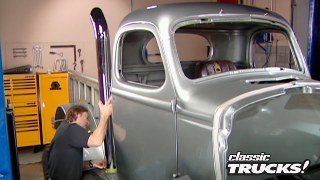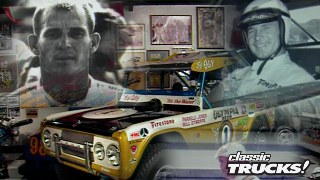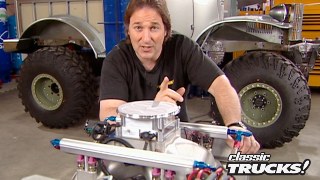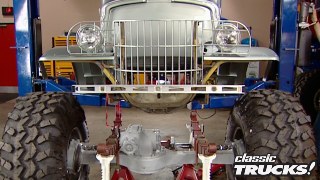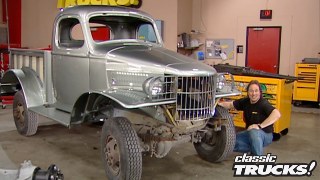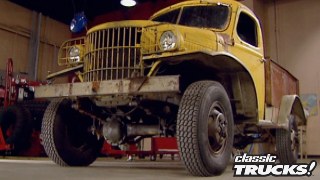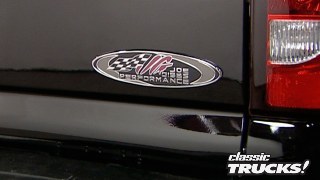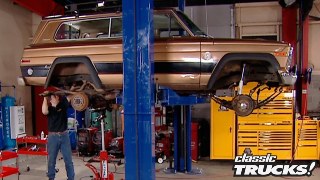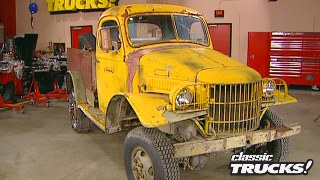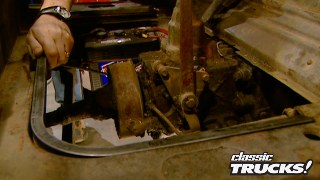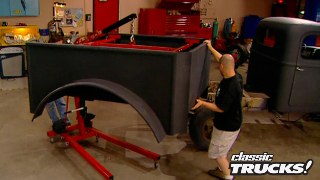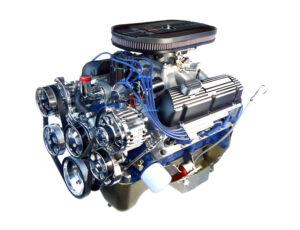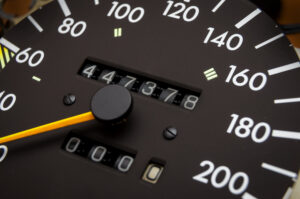More Sergeant Rock Episodes
Classic Trucks! Builds
Want more content like this?
Join the PowerNation Email NewsletterVideo Transcript
Hey, welcome to trucks.
You know, one thing that everybody loves is an old truck. You know, we've all seen them set out in a field or somebody's yard or grandma's barn and we've dreamed of getting that truck and bringing it back to life and reviving it.
The problem is the first step is just getting the darn thing running.
And that brings me up to today's show and a question that I get a lot. Listen to this
Stacy. I've got a 74 Ford pickup been sitting for four years. How do I get it running?
There's one in here been sitting two years, 1, 10 years, 25 years on and on and on.
They all wanna know the proper steps to revive a vehicle.
That is what I'm gonna show you today.
Ok. What I've got here is a 1941 Dodge army truck
that has been sitting in a field for years. It hasn't run in, who knows how long.
And I literally pulled it right out of the field and brought it into the shop. So it's completely untouched.
As you can see, it's still got weeds on it and old tire chains on the tires and a
custom made bed and check this out.
You got an old blanket covering the seat springs and that's all covered with rat crap.
Is this cool or what
now? Believe it or not,
I plan on driving this thing out of here and if I can get something like this running
just about anything else will be pretty easy. So, let's get to it.
Oh, yeah. Look at this,
man. I almost expect a chicken to come flying out of here, which brings up a very important point. If your truck has been sitting for a while, especially outside,
make sure you're being careful when you start going into it because all kinds of nasty things like to crawl in and make a home like snakes and possums and rats and skunks. Yeah, you get the idea. So be careful.
The first thing that you need to find out on a project like this
is what exactly you've got to work with. Now, if the motor is blown or if you've got mechanical damage, like a rod sticking out the side or something,
you might as well just pull the motor out and rebuild it
because you're not gonna get it to run.
So finding out if the engine is free and turns over is the first step. Now, if your engine is locked up, don't give up. Not yet. What usually happens is a little bit of condensation gets into the cylinders, causes a little bit of rust around the piston rings and the cylinder and
holds them together
and you can break that loose and this is how to do it.
Take some good penetrating lube, pop out your spark plugs
and give a good blast of lube down into those cylinders and let it sit.
Then
you can usually break it loose by taking a wrench, putting it down on the crank bolt and turning it.
Now, our motor, as you can see, turns over. Well,
so we are ready to go to the next step.
All right, the main areas that we're gonna have to address here are the fuel system and the electrical system.
And you don't wanna just hack this together because you want it to be reliable enough to where it'll start and run for you when you want it to. So we're gonna need some new parts and here's what they are.
First of all, it's a good idea to get a complete engine gasket kit for whatever you're working on. And in this case, I also got a carburetor kit because I know I'm gonna need that.
Now, you may not use all these gaskets. Heck, you probably won't, but you don't know what you're gonna need until you get in there and having the complete set.
Well, that saves you a ton of time running back and forth to the auto parts store. Also,
these master sets a lot of times they've got little gaskets in there that you cannot buy separately. So this is a good idea.
Now, you also need some fuel hose and a fuel filter. Now, I like to use the see through style because I can tell at a glance of my fuel pump is working and what kind of trash may be coming through the line.
Next is electrical, get everything that you're gonna need. In this case, it's points, condenser rotor
plugs, cap wires by getting everything to start with. You eliminate all the little electrical gremlins that can pop up toward the end. Now, let's dig into the fuel system starting with the carburetor.
Now, if your vehicle's been sitting for two years or longer,
uh, you really need to take your carburetor off and clean it out, especially if it's been sitting without an air cleaner like this one has because you have no way of knowing
what nasty things have crawled down inside there and made a nest. For example, check this out.
This obviously is the home of some sort of flying stinging insect
and your engine is not gonna run with a squat. If that gets down in there also,
gas will eventually go bad. It turns into kind of a sludgy varnish sort of thing
and it will gum everything up. So you need to clean it out.
Now, it doesn't matter if you're working on a two barrel, four barrel, Holly Edelbrock, whatever if you want your engine to run good.
You need to get a good clean, fresh supply of fuel to it.
The flo bowl will either be filled with old rancid gas and sludge or the dried powdery residue of it.
So, after disassembling the carburetor,
we'll completely clean it with solvent,
blow out the ports with air to clear any clogs
and then reassemble it using the parts and gaskets from the rebuild kit.
Finally, we install it on the engine.
Now, if the vehicle that you're working on is fuel injected, well, obviously you don't have to do this step because you don't have a carburetor,
but you do need to come in and drain your fuel rails and your fuel lines,
which is usually just a matter of coming in, undoing a line letting the fuel drain out.
Now, if your vehicle's been sitting a few years, you probably
don't have a slick aftermarket fuel injection, but that's all right
because your stock injection is gonna have lines and rails in a similar location. So you should be able to find them pretty easy.
Now, the next step involves every kind of vehicle because it is how to get old gas
out of a gas tank.
Ok. As you can see, we majorly lucked out here because we got a drain plug. Now, that's not something you see very often, especially on a newer plastic tank. Now, if you don't have a drain plug,
well, you got two choices. You can either siphon the gas out
or you can drop the tank and pour it out.
Uh, that is why we love the plug. We'll see you after this.
Hey, you're back. And that's a good thing because today we're dealing with an age old problem
on how to get an old rig running again after it's been sitting for a while.
Now, I've already gone through the fuel system by rebuilding the carburetor,
draining the gas tank and changing the fuel filters. Now
it's time to move on to another potential problem area.
That's the electrical system. So we might as well start at the bottom
and the spark plugs.
Oh, boy.
Now, you can try to clean these up and recap them and reuse them. But
you are still messing with an old spark plug that may not be any good anyway. And you're gonna find that out when you try to start that engine. Now, now new plugs are so cheap. It is not worth the hassle trying to restore one of these. So
just replace them. And then you know what you got
moving down the line, you have your plug wires. Now, just like your plugs. A replacement set of these is so cheap. It's really worth your while to replace them
because age and temperature and just general wear and tear will cause these to crack on you
and that'll allow you to lose some of your spark energy to your plugs. It
will also give you a heck of a shock if you happen to grab one of these while the engines running
at this point, if your vehicle is fuel injected or has a modern electronic ignition,
well, you are ready to move on to other things like oil and hoses, stuff like that.
If it's an older rig like this one is, well, you still have some ignition pieces to replace and they are all under the distributor cap
in the form of points and condenser and rotor and of course a new cap. Now, the most important thing here is that you need to know what your point gap is. Now, you can get that at an auto parts store or service manual.
Ok. That takes care of the engine electrical system. Now, since we're talking about electrical now is a good time to check your wiring, especially on an old rig like this that has been hacked on for years. Look at this,
you've got wiring coming through a metal firewall with no rubber grumme to protect it.
You've got original wiring that is literally just crumbling and falling apart.
And then you've got all kinds of very creative splices going on here.
Now is the time to fix this kind of stuff because if you don't,
when you turn that key, you know, you could put a whole new meaning to the term fire it up.
Of course, the last thing you need to deal with on the electrical system is a battery.
Now, most old vehicles have an old junk battery in them. So obviously that'll need to be replaced in this case is six volt. But another thing you need to look at are your cables and your ends.
Now, these
get corroded over time, it can give you a bad connection even though they may still look good on the outside. So if there's even a question that these might be bad,
you need to replace them. All right, we're gonna take a break, do a few more things
and when we come back, we're gonna try to fire this thing up.
Hey, welcome back to trucks. I am just about ready to try to start this 1941 Dodge military truck that was literally sitting in the field until today when I rolled it here into the shop. Now, the purpose of this is to try to show you the steps involved in reviving an old vehicle, kinda like that old junker sitting in your yard. Yeah. You know what I'm talking about now, we've already done the electrical system, done the fuel system. Now we're ready for fluid. So, first thing I'm gonna do is dump that old oil out of there and put something good in.
We'll follow up the oil with some antifreeze coolant. Now, before you just pour this stuff in,
take a few minutes and check your hoses because the last thing you want is cooling, going all over the engine when you start it.
Remember the hose is cheap. So if it's bad, replace it.
All right, the moment of truth, it is time to fire this thing and you doubters can step on back because this thing is gonna start.
All right,
here we go.
This is awesome.
And it really sounds good.
Look at this. No power steering, no brakes, no floor, but it's running under its own power. And that is what trucks is all about. This is great.
It goes without saying that trucks are extremely popular. You can work with them through the week and then you can play with them on the weekend. Now, boats on the other hand are also very popular. Matter of fact, most people that own a boat, use a truck to pull it with. Now, wouldn't it be cool if you could take a truck and combine
it with a boat into one unique vehicle? Well, it's been done and very successfully, but don't look for this cool rig down at your local dealership. No, no, this was a long time ago.
World War two. The army called the truck, the D UK. W the soldiers. They called it the duck.
Now, the D UK W was basically a six by six truck with front wheel drive and dual driving axles in the rear.
But that was really the only thing normal about this rig. But then again, this is not a normal rig. It floats.
Now, tires won't do you much good in deep water. So to make the duck move,
you have a big propeller mounted behind the rear axle.
A series of levers allowed the driver to choose to power the axles or the prop or both.
It was 31 ft long and had 18 inches of ground clearance and weighed in at a hefty 15,000 pounds pretty heavy for something that's supposed to float.
The engine is a GMC six cylinder which meant about 50 miles an hour was all you're going to squeeze out of it on land.
The tranny is a four speed and it was built back in the days before synchronizer. So
like most old trucks, double clutching is a must.
Now, this is where things get really weird because instead of a truck body,
you have what is basically a ship's hull wrapped around the drive train
and the size and design of the hull allowed the duck to handle some pretty rough water.
That way it could get troops and supplies ashore.
Now, obviously, you can't find AD UK W just anywhere
but we know a place in Chattanooga, Tennessee called
the Chattanooga Ducks.
Now, they not only restore D UK WS
but they also give tours on them. I'm
your host for this tour.
Driving the duck on the road is a workout for the driver, especially in downtown traffic with no power steering,
double clutching and the turning radius of the space shuttle.
You definitely have your hands full.
We're going to hire this guy. He's good
when you get to the water though is when this truck gets really fun.
Although I have to say, I did wonder if this big old heavy sucker was actually going to float.
What a cool feeling.
Once you're in the water, the duck will run along at a nice solid seven miles an hour, which is not really fast.
But remember this thing was designed to carry men and equipment ashore
and not pull a skier.
Now, most of the test drives I do are not things that you viewers have access to,
but this one is,
if you'd like to go for a ride in one of these amazing vehicles, give the Chattanooga Ducks a call and schedule one. You'll be glad you did.
Oh, yeah. Just tell them, Captain Stacy sent you
for today's first truck gear. We're gonna talk about one piece of equipment that everybody needs to have on their off road rig, some sort of auxiliary lighting because
the sun always goes down before you reach the end of the trail and wheeling at night. It's a lot of fun. Now, that being said
you need to check out these new lights from Warren and this is called the S DB one 60. It's a spot driving light
has a very tough, high impact housing.
Got a rock guard on the front and the H four bulb inside is very tough and durable. And of course, very bright.
Now, these are waterproof
and they have an adjustable base. So you can point these exactly where you want them to go. But the best part is
with just the push of a button, you can go from a driving beam, which gives you a nice wide light. So you can see around you as well as in front of you
to a spot beam which throws the light way out to you where you can see the obstacles before they become a problem.
So if you're serious about your off roading, especially at night,
you need to check out these new lights from Warren. They could be the best tool that you put on your rig.
Show Full Transcript
You know, one thing that everybody loves is an old truck. You know, we've all seen them set out in a field or somebody's yard or grandma's barn and we've dreamed of getting that truck and bringing it back to life and reviving it.
The problem is the first step is just getting the darn thing running.
And that brings me up to today's show and a question that I get a lot. Listen to this
Stacy. I've got a 74 Ford pickup been sitting for four years. How do I get it running?
There's one in here been sitting two years, 1, 10 years, 25 years on and on and on.
They all wanna know the proper steps to revive a vehicle.
That is what I'm gonna show you today.
Ok. What I've got here is a 1941 Dodge army truck
that has been sitting in a field for years. It hasn't run in, who knows how long.
And I literally pulled it right out of the field and brought it into the shop. So it's completely untouched.
As you can see, it's still got weeds on it and old tire chains on the tires and a
custom made bed and check this out.
You got an old blanket covering the seat springs and that's all covered with rat crap.
Is this cool or what
now? Believe it or not,
I plan on driving this thing out of here and if I can get something like this running
just about anything else will be pretty easy. So, let's get to it.
Oh, yeah. Look at this,
man. I almost expect a chicken to come flying out of here, which brings up a very important point. If your truck has been sitting for a while, especially outside,
make sure you're being careful when you start going into it because all kinds of nasty things like to crawl in and make a home like snakes and possums and rats and skunks. Yeah, you get the idea. So be careful.
The first thing that you need to find out on a project like this
is what exactly you've got to work with. Now, if the motor is blown or if you've got mechanical damage, like a rod sticking out the side or something,
you might as well just pull the motor out and rebuild it
because you're not gonna get it to run.
So finding out if the engine is free and turns over is the first step. Now, if your engine is locked up, don't give up. Not yet. What usually happens is a little bit of condensation gets into the cylinders, causes a little bit of rust around the piston rings and the cylinder and
holds them together
and you can break that loose and this is how to do it.
Take some good penetrating lube, pop out your spark plugs
and give a good blast of lube down into those cylinders and let it sit.
Then
you can usually break it loose by taking a wrench, putting it down on the crank bolt and turning it.
Now, our motor, as you can see, turns over. Well,
so we are ready to go to the next step.
All right, the main areas that we're gonna have to address here are the fuel system and the electrical system.
And you don't wanna just hack this together because you want it to be reliable enough to where it'll start and run for you when you want it to. So we're gonna need some new parts and here's what they are.
First of all, it's a good idea to get a complete engine gasket kit for whatever you're working on. And in this case, I also got a carburetor kit because I know I'm gonna need that.
Now, you may not use all these gaskets. Heck, you probably won't, but you don't know what you're gonna need until you get in there and having the complete set.
Well, that saves you a ton of time running back and forth to the auto parts store. Also,
these master sets a lot of times they've got little gaskets in there that you cannot buy separately. So this is a good idea.
Now, you also need some fuel hose and a fuel filter. Now, I like to use the see through style because I can tell at a glance of my fuel pump is working and what kind of trash may be coming through the line.
Next is electrical, get everything that you're gonna need. In this case, it's points, condenser rotor
plugs, cap wires by getting everything to start with. You eliminate all the little electrical gremlins that can pop up toward the end. Now, let's dig into the fuel system starting with the carburetor.
Now, if your vehicle's been sitting for two years or longer,
uh, you really need to take your carburetor off and clean it out, especially if it's been sitting without an air cleaner like this one has because you have no way of knowing
what nasty things have crawled down inside there and made a nest. For example, check this out.
This obviously is the home of some sort of flying stinging insect
and your engine is not gonna run with a squat. If that gets down in there also,
gas will eventually go bad. It turns into kind of a sludgy varnish sort of thing
and it will gum everything up. So you need to clean it out.
Now, it doesn't matter if you're working on a two barrel, four barrel, Holly Edelbrock, whatever if you want your engine to run good.
You need to get a good clean, fresh supply of fuel to it.
The flo bowl will either be filled with old rancid gas and sludge or the dried powdery residue of it.
So, after disassembling the carburetor,
we'll completely clean it with solvent,
blow out the ports with air to clear any clogs
and then reassemble it using the parts and gaskets from the rebuild kit.
Finally, we install it on the engine.
Now, if the vehicle that you're working on is fuel injected, well, obviously you don't have to do this step because you don't have a carburetor,
but you do need to come in and drain your fuel rails and your fuel lines,
which is usually just a matter of coming in, undoing a line letting the fuel drain out.
Now, if your vehicle's been sitting a few years, you probably
don't have a slick aftermarket fuel injection, but that's all right
because your stock injection is gonna have lines and rails in a similar location. So you should be able to find them pretty easy.
Now, the next step involves every kind of vehicle because it is how to get old gas
out of a gas tank.
Ok. As you can see, we majorly lucked out here because we got a drain plug. Now, that's not something you see very often, especially on a newer plastic tank. Now, if you don't have a drain plug,
well, you got two choices. You can either siphon the gas out
or you can drop the tank and pour it out.
Uh, that is why we love the plug. We'll see you after this.
Hey, you're back. And that's a good thing because today we're dealing with an age old problem
on how to get an old rig running again after it's been sitting for a while.
Now, I've already gone through the fuel system by rebuilding the carburetor,
draining the gas tank and changing the fuel filters. Now
it's time to move on to another potential problem area.
That's the electrical system. So we might as well start at the bottom
and the spark plugs.
Oh, boy.
Now, you can try to clean these up and recap them and reuse them. But
you are still messing with an old spark plug that may not be any good anyway. And you're gonna find that out when you try to start that engine. Now, now new plugs are so cheap. It is not worth the hassle trying to restore one of these. So
just replace them. And then you know what you got
moving down the line, you have your plug wires. Now, just like your plugs. A replacement set of these is so cheap. It's really worth your while to replace them
because age and temperature and just general wear and tear will cause these to crack on you
and that'll allow you to lose some of your spark energy to your plugs. It
will also give you a heck of a shock if you happen to grab one of these while the engines running
at this point, if your vehicle is fuel injected or has a modern electronic ignition,
well, you are ready to move on to other things like oil and hoses, stuff like that.
If it's an older rig like this one is, well, you still have some ignition pieces to replace and they are all under the distributor cap
in the form of points and condenser and rotor and of course a new cap. Now, the most important thing here is that you need to know what your point gap is. Now, you can get that at an auto parts store or service manual.
Ok. That takes care of the engine electrical system. Now, since we're talking about electrical now is a good time to check your wiring, especially on an old rig like this that has been hacked on for years. Look at this,
you've got wiring coming through a metal firewall with no rubber grumme to protect it.
You've got original wiring that is literally just crumbling and falling apart.
And then you've got all kinds of very creative splices going on here.
Now is the time to fix this kind of stuff because if you don't,
when you turn that key, you know, you could put a whole new meaning to the term fire it up.
Of course, the last thing you need to deal with on the electrical system is a battery.
Now, most old vehicles have an old junk battery in them. So obviously that'll need to be replaced in this case is six volt. But another thing you need to look at are your cables and your ends.
Now, these
get corroded over time, it can give you a bad connection even though they may still look good on the outside. So if there's even a question that these might be bad,
you need to replace them. All right, we're gonna take a break, do a few more things
and when we come back, we're gonna try to fire this thing up.
Hey, welcome back to trucks. I am just about ready to try to start this 1941 Dodge military truck that was literally sitting in the field until today when I rolled it here into the shop. Now, the purpose of this is to try to show you the steps involved in reviving an old vehicle, kinda like that old junker sitting in your yard. Yeah. You know what I'm talking about now, we've already done the electrical system, done the fuel system. Now we're ready for fluid. So, first thing I'm gonna do is dump that old oil out of there and put something good in.
We'll follow up the oil with some antifreeze coolant. Now, before you just pour this stuff in,
take a few minutes and check your hoses because the last thing you want is cooling, going all over the engine when you start it.
Remember the hose is cheap. So if it's bad, replace it.
All right, the moment of truth, it is time to fire this thing and you doubters can step on back because this thing is gonna start.
All right,
here we go.
This is awesome.
And it really sounds good.
Look at this. No power steering, no brakes, no floor, but it's running under its own power. And that is what trucks is all about. This is great.
It goes without saying that trucks are extremely popular. You can work with them through the week and then you can play with them on the weekend. Now, boats on the other hand are also very popular. Matter of fact, most people that own a boat, use a truck to pull it with. Now, wouldn't it be cool if you could take a truck and combine
it with a boat into one unique vehicle? Well, it's been done and very successfully, but don't look for this cool rig down at your local dealership. No, no, this was a long time ago.
World War two. The army called the truck, the D UK. W the soldiers. They called it the duck.
Now, the D UK W was basically a six by six truck with front wheel drive and dual driving axles in the rear.
But that was really the only thing normal about this rig. But then again, this is not a normal rig. It floats.
Now, tires won't do you much good in deep water. So to make the duck move,
you have a big propeller mounted behind the rear axle.
A series of levers allowed the driver to choose to power the axles or the prop or both.
It was 31 ft long and had 18 inches of ground clearance and weighed in at a hefty 15,000 pounds pretty heavy for something that's supposed to float.
The engine is a GMC six cylinder which meant about 50 miles an hour was all you're going to squeeze out of it on land.
The tranny is a four speed and it was built back in the days before synchronizer. So
like most old trucks, double clutching is a must.
Now, this is where things get really weird because instead of a truck body,
you have what is basically a ship's hull wrapped around the drive train
and the size and design of the hull allowed the duck to handle some pretty rough water.
That way it could get troops and supplies ashore.
Now, obviously, you can't find AD UK W just anywhere
but we know a place in Chattanooga, Tennessee called
the Chattanooga Ducks.
Now, they not only restore D UK WS
but they also give tours on them. I'm
your host for this tour.
Driving the duck on the road is a workout for the driver, especially in downtown traffic with no power steering,
double clutching and the turning radius of the space shuttle.
You definitely have your hands full.
We're going to hire this guy. He's good
when you get to the water though is when this truck gets really fun.
Although I have to say, I did wonder if this big old heavy sucker was actually going to float.
What a cool feeling.
Once you're in the water, the duck will run along at a nice solid seven miles an hour, which is not really fast.
But remember this thing was designed to carry men and equipment ashore
and not pull a skier.
Now, most of the test drives I do are not things that you viewers have access to,
but this one is,
if you'd like to go for a ride in one of these amazing vehicles, give the Chattanooga Ducks a call and schedule one. You'll be glad you did.
Oh, yeah. Just tell them, Captain Stacy sent you
for today's first truck gear. We're gonna talk about one piece of equipment that everybody needs to have on their off road rig, some sort of auxiliary lighting because
the sun always goes down before you reach the end of the trail and wheeling at night. It's a lot of fun. Now, that being said
you need to check out these new lights from Warren and this is called the S DB one 60. It's a spot driving light
has a very tough, high impact housing.
Got a rock guard on the front and the H four bulb inside is very tough and durable. And of course, very bright.
Now, these are waterproof
and they have an adjustable base. So you can point these exactly where you want them to go. But the best part is
with just the push of a button, you can go from a driving beam, which gives you a nice wide light. So you can see around you as well as in front of you
to a spot beam which throws the light way out to you where you can see the obstacles before they become a problem.
So if you're serious about your off roading, especially at night,
you need to check out these new lights from Warren. They could be the best tool that you put on your rig.

